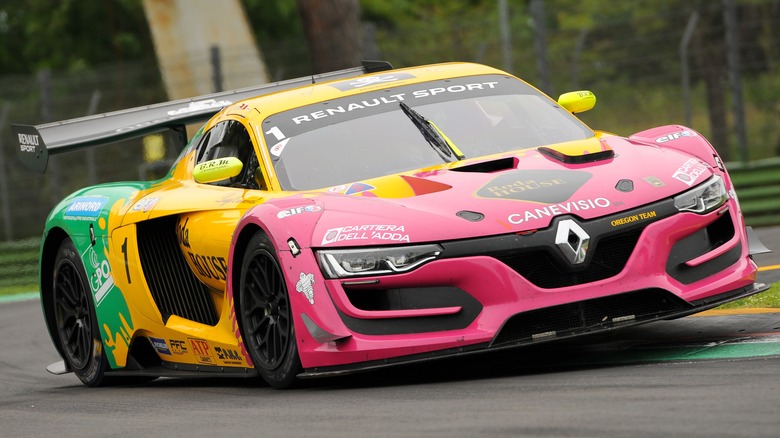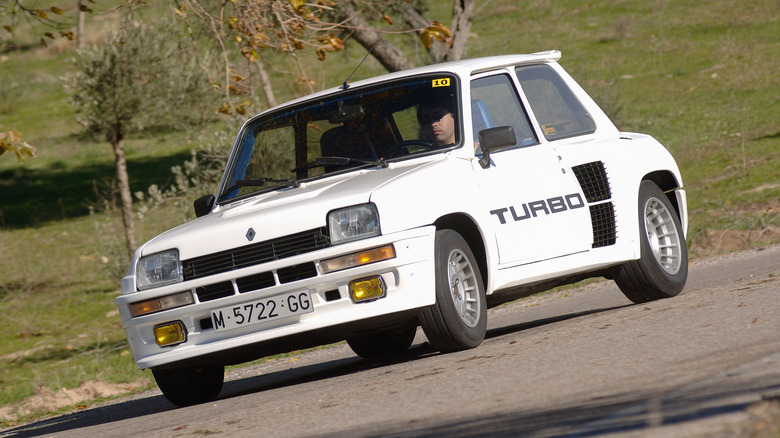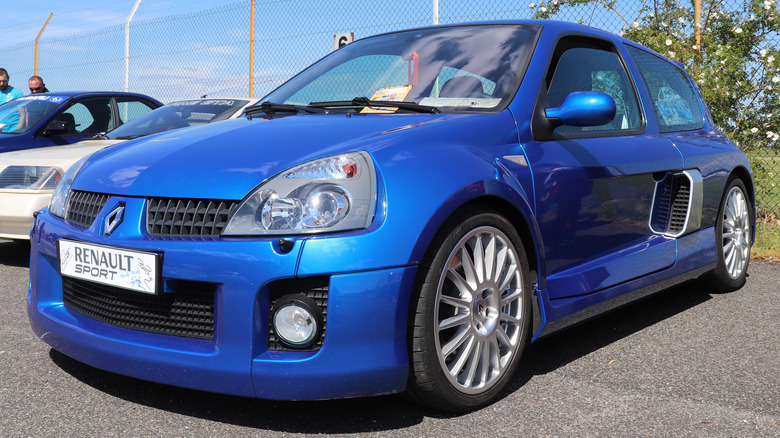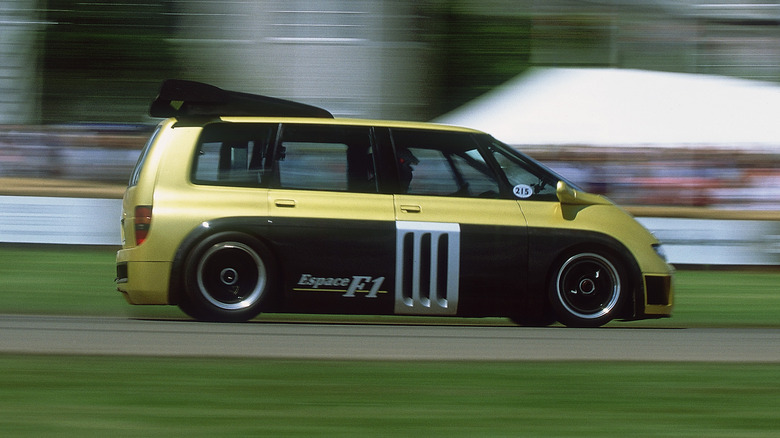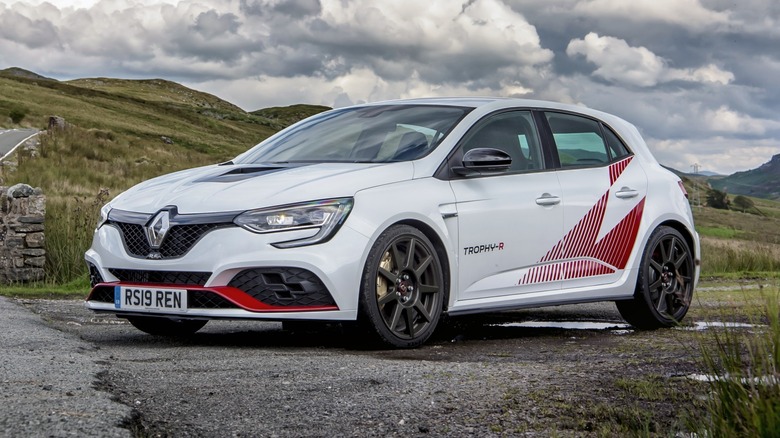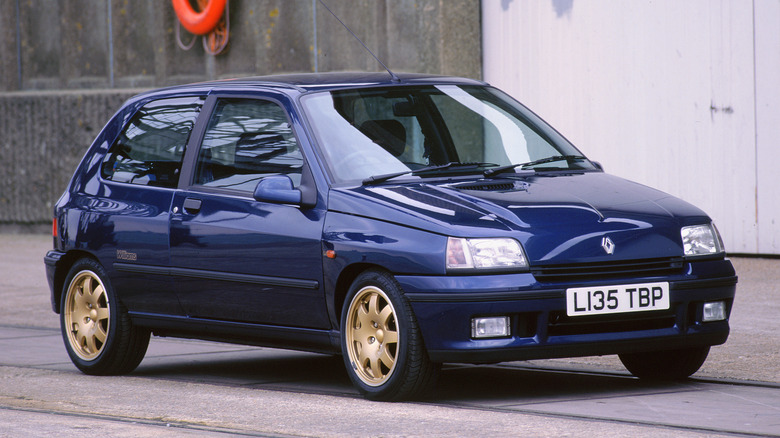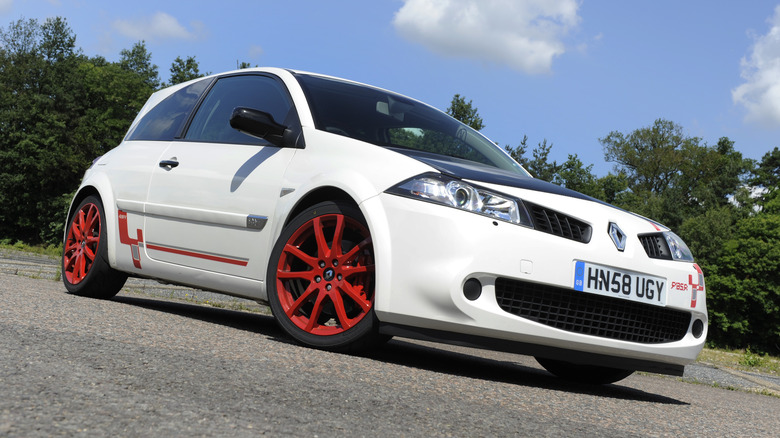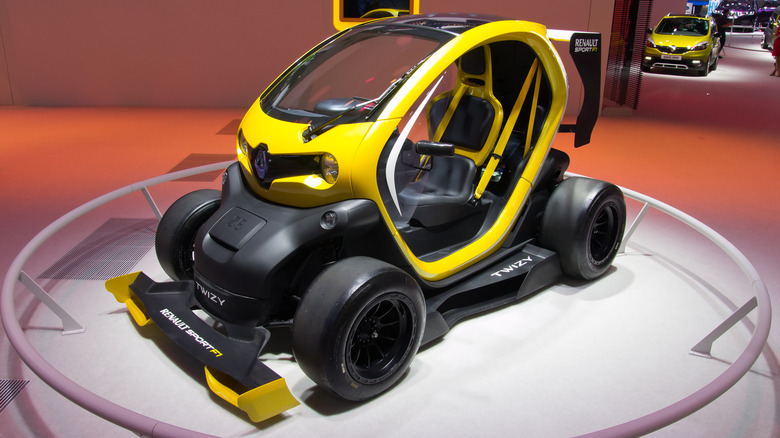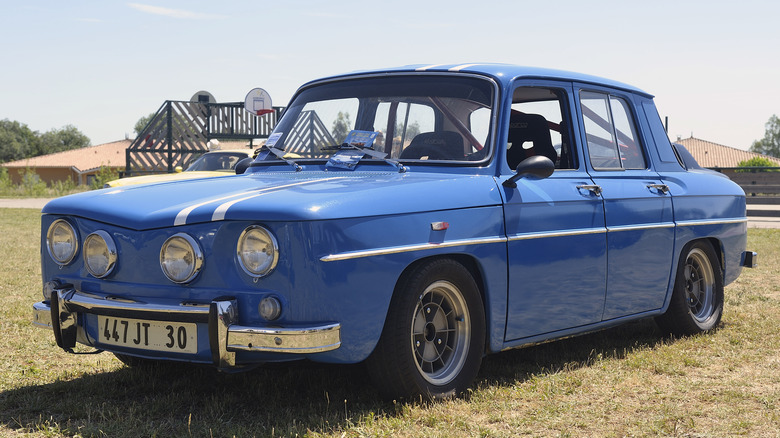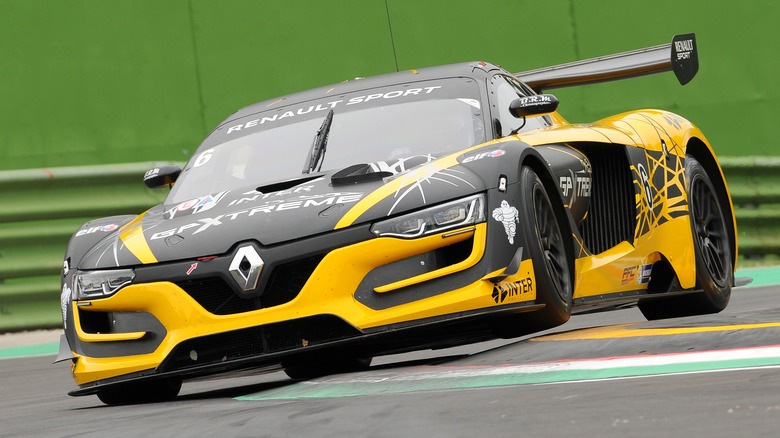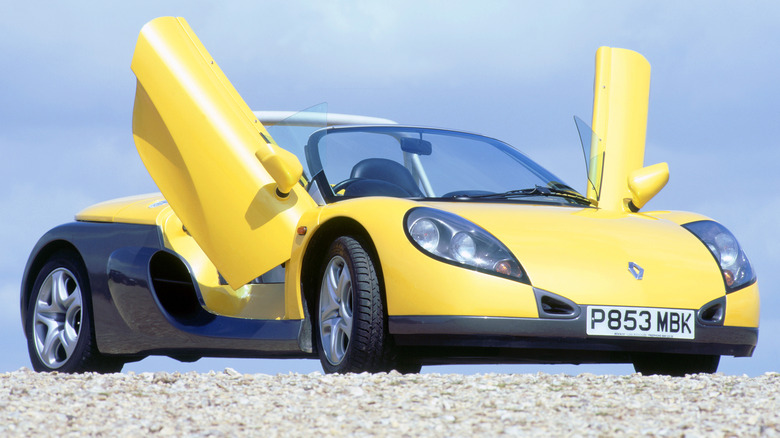10 Of The Best Renault Cars Ever Made
Renault's cars are, in many ways, the epitome of French carmaking. They're consistently different from the rest, for better or for worse, with plenty of underwhelming duds over the years alongside the brand's enviable back catalog of greats. It can be easy to overlook how many greats there are, too — from groundbreaking hot hatches to V10-powered minivans, Renault's importance in the performance car world should not be underestimated. Of equal importance is the brand's long-time partner and now subsidiary, Alpine, but for the purposes of this article, only cars that shipped without an Alpine badge are included.
Many of the greatest Renaults were devised by Renault Sport, an in-house division that handles everything from limited-run hot hatch specials to the brand's top-level racing efforts. However, Renault's motorsport pedigree goes back decades before the formation of Renault Sport, with its first sports car competing on the rally stages of the Tour de Corse, beating rivals from some of the world's greatest racing brands in the process. The French carmaker's history is a long and storied one, but these cars stand out among the rest as particular highlights of its output to date.
Renault 5 Turbo
Perhaps one of the most instantly recognizable hot hatches ever made, the Renault 5 Turbo is famous not only for its unique shape but also for its success in rallying. Its power output might not seem like much by modern standards — 160 horsepower from its turbocharged 1.4L four-cylinder is on par with some economy hatchbacks today — but when it launched, it was the most powerful French road car. The regular Renault 5 was far from an ideal candidate for a race-ready rally car, and so in order to make it competitive, the French manufacturer tasked famed automotive designer Marcello Gandini with reworking it.
Gandini significantly widened the car but kept its iconic boxy styling. Power was sent to the rear wheels rather than the front as with the regular 5, and the engine was mid-mounted, with the rear seats taken out to accommodate it. The 5 Turbo was built over two series, with Series 1 cars featuring the most bespoke components, and Series 2 built with slightly more parts from Renault's parts bin. Both generations remain highly sought after among enthusiasts since there's never been anything quite like them since. It might not stay that way forever, though: Renault's recent unveiling of the R5 Turbo 3E concept hinted at a future electric revival for the 5 line, although nothing has been officially confirmed for now.
Renault Clio V6
Much like the Renault 5 Turbo, the Clio V6 lost its back seats to accommodate its engine, and sported wide, redesigned bodywork that instantly differentiated it from lesser Clios. However, rather than use a four-cylinder engine, a 3.0L V6 engine was used, making 226 horsepower in early models, and 255 horsepower in later cars. That power pushed the Clio V6 to a top speed of 155 mph in Phase 2 cars, matching the top speed of flagship sports cars from the likes of BMW and Mercedes-AMG. The car was developed in conjunction with TWR, a British engineering and racing outfit that'd previously worked on the Jaguar XJ220 and Nissan R390 GT1.
It was originally presented in concept form in 1998, and after a very positive reception, production began two years later. Between 2000 and 2005, a total of 2,822 examples would be built. The regular Renault Clio might be one of Europe's favorite economy hatchbacks, but the Clio V6 proved that it could also cut it with the very best of the hot hatch world on the road and the track.
Renault Espace F1
Renault has always had a reputation for producing cars that were different from the crowd, and none stand out more so than the mad one-off Renault Espace F1. Your eyes don't deceive you — this is indeed a race-ready French minivan, sporting a custom carbon fiber chassis derived from the 1993 Williams Formula 1 car. Williams had seen great success in the 1992 and 1993 F1 seasons with a Renault V10 engine powering its cars, and that V10 was borrowed for the Espace F1. Its redline was north of 13,000 rpm and its total power output was around 800 horsepower.
For optimal weight distribution, the V10 was mid-mounted, with the two rear seats of the car sitting just a couple of inches from the top of the engine. The car's bodywork, however, remained as close to the standard car as possible, albeit with a few extra aero bits and air intakes. Since the Espace F1 was created essentially as a marketing tool, only one working example was produced. It succeeded in its goal of getting people talking about the Espace minivan again, even if, after initial press drives were complete, some journalists were left stretching their heads about how it was even possible for Renault to have built such an implausible car.
Renault Megane RS Trophy-R
The latest and greatest limited-run hot hatch that Renault has to offer is also arguably its best yet, with a forensic level of attention to detail that ensures it's significantly lighter than its peers, but no less powerful. The Megane RS Trophy-R takes the standard Megane RS and strips out absolutely everything unnecessary from the car — the back seats are gone, the rear wiper is removed, and even the badges are replaced to save a few extra ounces. All in all, the car weighs just 2,879 lbs. Only the most bare-bones roadsters tip the scales at less.
All of this weight saving was not in vain: the Trophy-R set a new front-wheel drive Nürburgring lap record when it debuted in 2019. However, actually buying one of these record-breaking hot hatches is neither easy nor cheap. Just 500 examples of the car were built between 2019 and 2021, and with all the pricey optional extras added, the car cost the equivalent of around $81,000. That's serious money for a front-wheel drive hot hatch, but all 500 examples sold despite its sky-high price.
Renault Clio Williams
It might not be able to match the latest Renault hot hatches on paper, but the Renault Clio Williams was nothing short of a genre-defining car when it launched in 1993. It borrowed the name of the successful Renault-affiliated F1 team, but in fact, much of the development was done by the manufacturer's in-house Renault Sport division, with the original goal of homologating the Clio for rally use. A total of 2,500 cars were originally planned, but high demand saw more than 12,000 examples produced in total.
The little Clio packed a 2.0L engine making around 150 horsepower, making it one of the most powerful cars in its class at the time. Its distinctive blue paintwork was paired with blue interior accents, including bright blue seatbelts, and gold wheels emphasizing its range-topping (and indeed, segment-topping) status. Many examples haven't survived to the present day, and the pristine examples that do command hefty premiums at auction. In late 2022, a new record was set when a low-mileage Clio Williams fetched €73,904, equivalent to around $71,686 at the time.
Renault Megane R26.R
A track-day toy that was also a blast on the road, the Renault Megane R26.R was the first in a line of limited-run Megane specials that focused on stripping out weight and improving handling to record-breaking levels. It set a record time on the Nurburgring's Nordschleife at the time of its release, although that record has since been broken many times, including multiple times by Renault's own newer Megane specials.
The R26.R made its presence known with a carbon fiber hood, bright exterior graphics, and a visible roll cage in the rear where the seats used to be. The engine was left untouched from the Megane R26, with 227 horsepower available from the 2.0L four-cylinder. Top speed and 0-62 mph time, however, were both improved, standing at 148 mph and 6.0 seconds, respectively. While the R26.R has been ultimately eclipsed by its successors in performance terms, it remains a milestone in Renault Sport's hot hatch history, and may well appreciate in value as previous revered Renaults have done as the decades pass.
Renault Twizy F1
Renault's tiny Twizy electric car is hardly the obvious candidate for a go-faster conversion, but clearly someone at Renault looked at it and thought, ". . . maybe we should make a Formula 1-inspired one." The regular Twizy is a low-speed EV designed for crawling through city traffic and is perhaps best compared to a road-legal golf cart. It's a niche car in standard form thanks to its limited practicality and unusual looks, but the mad Twizy F1 takes things up a notch.
While only a concept, the Twizy F1 was a fully functional one-off, with the KERS system from a Formula 1 car to increase its peak power to 97 horsepower. In a car so light, that meant a 0-60 mph time of around six seconds, and a top speed of around 68 mph. A suite of extra aero bits including a carbon fiber front splitter and rear wing add an extra layer of absurdity to the already odd-looking car, while F1-style wheels round out the comprehensive overhaul. The Twizy F1 debuted in 2013 as the spiritual successor to the equally hilarious Espace F1, and much like the minivan, it was only ever intended to be an attention-grabbing special project, so there's no way to buy your own Formula 1-spec Twizy.
Renault 8 Gordini
One of the earliest "hot" Renaults, the 8 Gordini was a sportier variant of the best-selling R8. It was the brand's first proper foray into the racing world and caused a stir when it won the 1964 Tour de Corse, fending off competition from Porsche and Alfa Romeo. It was also popular with customers, selling around 11,800 units between 1964 and 1970. Early versions of the car boasted 95 horsepower from a 1.1L engine, but a larger 1.3L version was unveiled in 1966 with 110 horsepower.
It proved to be more than a one-trick pony in its rallying career, winning the Tour de Corse twice more in 1965 and 1966, alongside various other, smaller rally events around Europe. It's a long way from fast by modern standards, but the Renault 8 Gordini paved the way for the line of hot hatches that came after it, which would in turn provide the foundation for many of the automaker's most celebrated cars.
Renault RS.01
When the RS.01 was announced in 2014, it had plenty of enthusiasts excited. It was built for a single-make racing series, with the eventual aim of homologating the car to enter GT3 races, too. Its 3.8L V6 engine was borrowed from the Nissan GT-R and made around 550 horsepower, while its chassis was a full carbon-fiber affair designed by Dallara. Unfortunately, things didn't quite go to plan for the racing series: it was canceled after two seasons when it proved to be financially unviable, and RS.01 cars have only made a handful of appearances at other races since.
Since it was designed as a pure race car, Renault never planned to make a road-legal version — or at least, no plans were ever made public. That means it's almost impossible for enthusiasts to see an RS.01 in the flesh today, which is a huge shame. In an ideal world, Renault would have launched the car in both road-legal and race-ready versions and transformed its image from a hot hatch specialist to a full-blown supercar maker. In reality, though, the RS.01 remains one of the brand's greatest forgotten cars.
Renault Sport Spider
Another missed opportunity for Renault was the release of the Sport Spider, the first car to be released with the "Renault Sport" badge and a significant departure from anything it had made before. It was a lightweight roadster with a 2.0L four-cylinder engine making 148 horsepower. So far, so good — the Spider took heavy inspiration from the classic Lotus formula, while the British brand itself was relying on an aging lineup at the time that had strayed somewhat from the original lightweight ethos.
Unfortunately for Renault, it launched the Spider in 1996, and shortly after, Lotus launched its own new roadster, the Elise. The latter car would go on to single-handedly revitalize the brand, becoming one of its most iconic models to date, while the Spider never quite sold in the numbers that Renault had hoped for. With the inevitable comparisons between the Spider and the Elise, it was the Elise that was crowned the better sports car of the two, and with that, the Renault's fate was sealed. Production estimates for the Spider vary between 1,600 and 1,800 examples, with Renault unceremoniously retiring the car in 1999 after years of low sales. Nonetheless, take the Spider in isolation and it's a great sports car by all accounts, with plenty of poke and a refreshingly back-to-basics feel. If the Elise had debuted just a few years later, perhaps the Renault might have got the credit it deserved from the press and from buyers.
